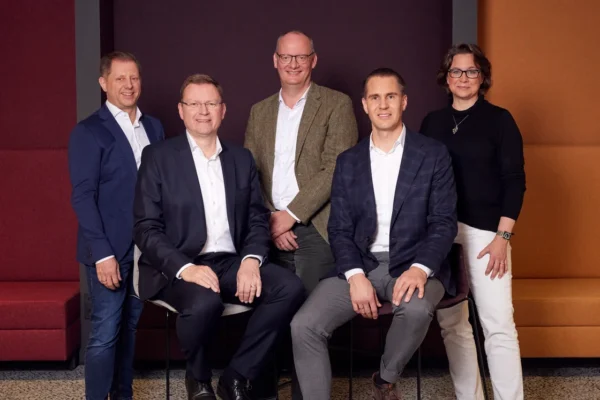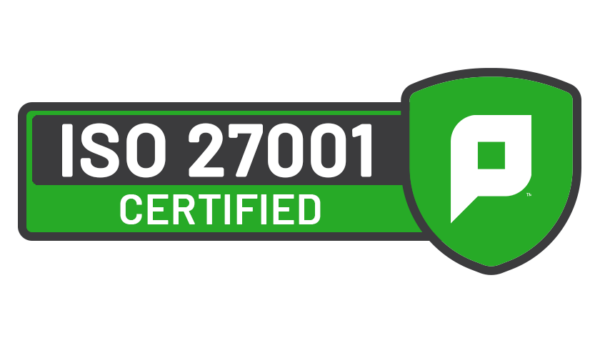Above, top row: De Blasi, Farrell, Hart, McWilliams; bottom row: Parker, Sabir, Strammiello
Whether ECM/document management, production print solutions, print management, or an MPS solution, you’ll find a supply chain that’s far from broken.
Have you noticed how no one is having issues with software in this era of supply chain disruptions and backorders? Software is supply-chain- and backorder-proof, which means if your product offerings include software, you’ll always have something to sell. It’s difficult to imagine a dealer in 2022 that doesn’t already sell some type of software or use it to enhance its MPS or managed IT offerings. This month, we feature representatives from software companies who examine various subjects, from encouraging sales reps to sell more software to finding recurring revenue to supporting the products they sell. They also update us on their latest introductions and enhancements, examine the importance of partnerships, and offer their take on the difference between dealers who successfully sell software and those who don’t.
Our panel includes Nicola De Blasi, CEO, MPS Monitor; Dave Farrell, head of global GtM, PaperCut Software; Mark Hart, executive director of business development and national accounts, ACDI; Jeff McWilliams, VP sales, North America, ACDI; Ben Parker, director of sales, Rochester Software Associates; Samina Sabir, communications director, DocuWare; and Chris Strammiello, senior vice president, worldwide sales and alliances, Kofax.
CR: What strategies do you recommend to sales managers to encourage their sales reps to pay more attention to the software sale?
De Blasi: It is important to emphasize to sales teams that software plays an essential role in data capture and, as we know, data is the new oil. The digital economy thrives on data because it is where intelligence and business insights lie, and it is where new opportunities exist for both end-users and dealers.
More pragmatically, many customers respond positively to the SaaS [software-as-a-service] concept. Its recurring revenue business model has many benefits. First, it means customers know in advance what they will pay for software (or a service) over a period of time, which makes their financial planning easier. Second, it ensures customers are using the most up-to-date software, enabling them to remain competitive while also providing them with the peace of mind that their software adheres to the latest security standards and guidelines. Finally, it ensures that dealers have a regular revenue stream.
The world is moving at an unprecedented rate, so an important KPI [key performance indicator] is an absolute need for business agility and for it to be applied with skill, accuracy, vision, and speed. In today’s world, replicating past achievements is the absolute opposite of business agility for success tomorrow. That’s why whether it is used to improve your own operations or to help solve your customers’ problems, software is a key component of business agility. Leveraging software to improve your business isn’t limited to a smart fleet management system or a smart platform; even something that simplifies completing and filing your taxes can help your business be more agile. Only an agile business underpinned by software can be faster and offer better value, so it’s important to focus on software sales.
Farrell: Like most great questions, it may start by asking a precursor question to the sales manager: “Do you believe that by attaching software, you’ll be better positioned to achieve your sales goals?” Let’s assume one important goal is helping your sales reps retire quota targets. By connecting software to the MPS contract, your sales reps can better achieve commission targets by:
- Increasing the average selling price on the deal.
- Gaining insights into customer usage behaviors that give them an opportunity to attach additional IT products or services.
- Leveraging new software add-ons as a vehicle to renew MPS contracts. There are many software solutions that add real value, such as print queue deployment (printer enablement), document capture and automation solutions, and sustainability tools to help identify and cut waste, just to name a few.
At the end of the day, compensation drives behavior. The most successful sales managers have adjusted their compensation plans to reward software attachments and acknowledge the importance of recurring revenues. Avoid overcomplicating this in the early days. Start by including a software attachment rate target as a condition for eligibility in your company’s President’s Club award or consider making 20% of sales reps’ commission tied to a software sales target. Your sales reps will find they can be far more consultative once software is attached.
McWilliams: My dad was on the diving team in high school. So naturally, I wanted to dive when I got into high school. I was flippy and twisty at a young age at the city pool. My dad told me, “Your body follows your head, and your head follows your eyes.” I think about that from time to time. Where you’re looking is likely where you’ll go. So, what are sales managers looking at regarding goals or objectives? Strategies and key metrics that will help them get to where they’re going. But you want to go there first.
Objectives might include winning more net new or “zero base” customers, retaining more customers with a positive software and hardware experience, and separating themselves from the competition.
As far as strategies, what strategies are you looking to build around? Weekly sales meetings allow you to review progress against software solutions-selling goals. What kind of vendor support can you get for creation/tracking/supporting this initiative? How are you training periodically to sharpen skills and to create sales team confidence? Can you set up a time-based contest where proposals that include software solutions qualify as an entry? Draw weekly, reward publicly.
For key metrics, consider what scoreboard you are looking at. Is it software demos, software proposals, or average deal size that includes software? Review NPS scores from customers who purchased software with their hardware.
Parker: Focus on the print-production process and how print jobs come into the print shop. By asking questions about these areas, sales reps will uncover pain points and a need for solutions to simplify and remove steps, particularly manual steps. Understanding and meeting these needs demonstrate your knowledge about the printing process and will earn you the customer’s respect. Whoever “owns the workflow” from a software perspective is who usually will retain and increase the business with the customer, including hardware.
Production print offers many workflow-software opportunities. Production equipment needs software to operate. Knowing this, it’s profitable to stay educated about the latest releases and trends in the software world. You don’t have to be an expert; that is what software providers like RSA are for. Knowing the issues to listen for and the right questions to ask can make you a great solutions provider who brings in the experts.
Finally, with current equipment and consumable supply-chain issues impacting hardware sales cycles, we suggest discussing workflow software right now. Having these discussions keeps you in touch with the customer, solving their workflow issues while awaiting hardware delivery.
Sabir: Sales managers can advise their reps that the first thing to do once they start a conversation is to listen, gather all the background information on the business, and understand how it currently works and what processes are in place. A holistic approach makes it easier to quickly identify pain points and ways in which the software can address them. Intelligent listening is the key, and not every business needs a company-wide solution! Selling them what they need while showing how the software is scalable and can be implemented in small or large steps and expanded to different departments is what helps seal a sales deal and leaves the customer feeling happy and secure in the choice they made.
Strammiello: We recommend two things. First, sales managers should focus on enablement. Reps that understand the software market, the software itself, the value proposition and use cases, and how software amplifies the value of the hardware will always find more success. Vendors like Kofax can help with all facets of enablement. Second, managers should persuade their reps with actual numbers. Sales that include software are substantially larger transactions; they’re longer-lived with more upgrades and add-ons. Further, the software market is growing rapidly, while the hardware market is experiencing slow to no growth.
CR: What are some of the new or enhanced products you are providing to the channel, and why should dealers care?
De Blasi: MPS Monitor recently unveiled its new Data Collection Agent (DCA) version 4. The new version brings a wealth of innovative and revolutionary features that are, in most cases, first to the market. It enables dealers and managed-print-services providers to benefit from instant, real-time access to devices, further integration with other market-leading solutions, and increased support and security. DCA 4 is a complete redesign and rework of the award-winning MPS Monitor DCA, which, over the last 12 years, has been installed in more than half-a-million customer networks and is currently used by thousands of dealers to manage more than 1.2 million printing devices across 60 countries.
Dealers should care because adding value is an intrinsic part of the service they deliver to customers. With the new DCA version 4, we have made that job even easier for them through new features that range from real-time connection to device web access, multiplatform support, granular data collection, optimized network discovery, and improved security and support, as well as integration with PaperCut. All those features are available immediately to all MPS Monitor users by simply installing the new DCA 4 on the network where printers are connected, so the time-to-value return is very rapid.
Farrell: At PaperCut, we start by identifying the trends impacting the market or end-users. Some of the more relevant market dynamics we’re aligning our roadmap to are remote and hybrid working, the shift to cloud printing and remote management, subscription-based print services, security and zero trust, and assisting companies to achieve their sustainability goals.
PaperCut continues to put a lot of development into our new cloud-native SaaS platform for print management in the cloud. PaperCut HIVE is 100% sold and supported by our global dealer network of 7,000-plus partners. This new cloud print management platform leverages IoT [internet of things] technology to keep documents local but also removes the need for an onsite print server. PaperCut continues to invest in a dedicated channel of Authorized Solution Centers that play a vital role in assisting print resellers and OEMs in pre- and post-sales support of our software.
Sustainability has always been at the heart of what we do at PaperCut and was the genesis for our founders taking their first steps in creating the market-leading solution we have today. In just a few short weeks, we’ll be delivering an exciting new Forest Positive program to our PaperCut MF and PaperCut HIVE print management solutions. PaperCut Grows enables businesses to offset their print consumption by planting trees through a reforestation offering. PaperCut takes care of all the tree planting logistics, and our software provides system administrators with the visibility and tools to engage their employees and customers as they progress on a Forest Positive Print journey. Time to make a sales call to the chief sustainability officer!
Hart: The product we are very excited about today is a software platform, the cloud. We feel there is so much potential in helping end-users navigate their software journey to the cloud. Today, we are offering Software-as-a-Service (SaaS), Platform-as-a-Service (PaaS), and Infrastructure-as-a-Service (IaaS) opportunities with the common goal of delivering cloud-based resources to clients when and where they need them. Our ACDI portfolio covers products and services such as PaperCut HIVE—native cloud print management (SaaS), Scanshare Enterprise—capture and workflow automation (SaaS, PaaS) as well as ACDI Cloud Solutions that enables our dealers to provide a private cloud offering for any of their customers’ needs.
Adjacency alert! Electric vehicle charging stations have reinvigorated many of the top entrepreneurs in our industry. Terra Energy Services by ACDI provides partners the opportunity to bring new technology, make a positive impact on the environment, and participate as an innovative, early adopter in the acceleration of electric vehicles within their markets.
Parker: RSA has new releases of our four key products: web-to-print, output management, prepress software, and variable data software. Why a dealer should care is that the current environment’s challenges—staffing shortages, supply chain issues, short print runs, and a need for growth and diversification—make it imperative to implement solutions that automate and use fewer staff to produce work.
With new innovations and customer-requested features, each new RSA release further reduces manual touches and increases efficiency to provide game-changing automation—from submission to output and everywhere in between—that will keep your customers competitive. Releases include:
- WebCRD Web-to-Print: In addition to WebCRD’s submission, production, and automation abilities, there is a new collaboration feature right inside WebCRD.
- ReadyPrint Prepress: Achieve higher automation levels using the new web-based automation engine with an improved workflow builder to intelligently automate the process from file receipt through production.
- ImpactVDP: Automate VDP [variable data printing] from a data feed with no human interaction and create variable templates faster with more capabilities and automation.
- QDirect output management: Save time and money by adding the ability to leverage email to automate job onboarding and output, including electronic delivery. Optimize production with grouping and batching enhancements.
Sabir: We continue to enhance our cloud-based Preconfigured Solutions. In addition to our original products for invoice processing and employee management, we’ve also added a Smart Document Control, which in an era of growing cybersecurity threats does exactly what the name suggests and provides tight control of access permissions for security and confidentiality. DocuWare version 7.6 will also be released soon and comes with its own set of enhanced integration functions with third-party software.
Strammiello: We’re currently rolling out our cloud SaaS offerings such as Printix, AP Essentials, and SignDoc Cloud to the dealer channel. These solutions are quick-and-easy to stand up with minimal resources required for implementation and support. This gives the dealer something new to sell to their customers that doesn’t depend on a hardware implementation. These products also avail themselves to a host of additional revenue-producing services.
CR: Dealers love good margins and recurring revenue. Can they get that from your software? If so, what kind of margins and recurring revenue can they expect?
De Blasi: Some of the core reasons dealers choose MPS Monitor are its high levels of integration, innovation, and security. Dealers realize that with MPS Monitor, they can do their job with fewer resources, in less time, and in a more efficient way. The results are clear cost reductions, margin increases, and revenue flowing in month after month.
It helps an MPS provider to assess their entire range of printing resources and look for ways to consolidate and optimize printers for their customers, which saves money in the long run.
This helps the dealer evolve their role, from that of merely a supplier to that of a valuable advisor. In such a position, dealers may find that they end up being deeply involved in IT decision-making processes and needs, enabling them to provide an additional service with the benefits of more margin and the potential for long-term customer loyalty.
MPS Monitor is a modern system centered on ease of use, and it offers integration with CRM and ERP. Cloud and SaaS-based, it complies with all of the security standards like ISO 27001, AICPA SOC2, and the GDPR mandate. It can be easily configured to provide reports and statics predefined or customized using embedded business intelligence analytics. By fully exploiting the platform’s capabilities, dealers can learn how to optimize their processes every day, resulting in a top-class service for their customers. And they will see profits increase almost automatically.
Farrell: Good business starts by retaining customers. We’re proud to say that PaperCut retains 94% of all our software customers with usage horizons well beyond five years. We did some benchmarking with a few print dealers and found some interesting results. When PaperCut’s print management software was attached, the deal sizes actually grew roughly 10% to 13%, and win rates were significantly higher compared to non-software attached deals. This makes sense when you think about the added utility offered by attaching software. For every $1 of software sales, a typical dealer attaches another $10 in hardware and services revenue. That makes for a pretty good business case to attach more PaperCut software. Overall margin dollars will be higher when you attach PaperCut software, especially when considering higher Customer Lifetime Value (CLV) generated by ongoing consulting and proactive monitoring services.
Hart: Software is always a great way for dealers to earn extra margin and recurring revenue with their customers. The ability to add professional services with a software sale gives our dealers the opportunity to charge their own custom billable rates to establish a far superior margin than they might see on a hardware-only deal. The most successful dealers have found a way to sell and market software directly to their end-users as a standalone offering rather than tied to the equipment as a one-time sale. These dealers are seeing margins of 60%-70% on these types of recurring revenue opportunities with software and PS combined.
Parker: RSA solutions provide solid margins managed by the dealer and, when bundled with printers, drive excellent recurring margins. Because RSA solutions are unique and solve specific workflow issues, this creates a unique situation where margins can be kept high, sellers are protected from future competitive threats, and long-term recurring revenue can be offered. RSA provides turnkey solutions with very little required dealer involvement, further increasing margins.
Sabir: The value of being an authorized dealer is, of course, about the dealer growing their own business. The speed with which our cloud-based solutions can be implemented allows dealers to take on more customers than ever before and become more profitable through new and recurring revenues. More new customers and more recurring revenue is a win-win for any dealer. We’ve seen a growth of approximately 75% in new cloud customers since 2021. DocuWare cloud solutions lend themselves particularly well to customer growth, as well as recurring revenue sources. This year, we are celebrating 10 years of successfully selling our cloud-based solutions. We continue to share our learnings with our dealers, and they continue to benefit from our wealth of experience in the cloud arena.
Strammiello: Software sales offer robust margins and lead to consistent add-on sales and predictable recurring revenues. Since transactions aren’t necessarily tied to a lease period, these recurring revenues don’t have to tie to the hardware cycle, creating a more balanced revenue mix.
CR: For those dealers that are most successful selling and/or using your software, what are they doing differently from those that make the occasional sale?
De Blasi: The dealers who are consistently selling software successfully are the ones that have taken a long-term view of their business, their customer base, and the brands they chose to represent. By taking the time to understand the evolving needs of their customers, they can recommend the most appropriate long-term solutions. This builds trust, which is the foundation for loyalty. Equally, software vendors and manufacturers want to partner with dealers who have adopted this approach, as often the feedback the dealers receive from their long-term customers can drive product improvements that even better meet the needs of end-users. The “sell-and-forget” model rarely brings anything fresh in terms of ideas or solutions that bring value, nor is it a foundation for any long-term relationship.
Farrell: The dealers who really believe in leading with PaperCut’s print management software tend to adopt several of the following, including getting to know their customers better, offering flexible compensation models, offering proactive support, taking advantage of sales and technical certifications, using PaperCut software products internally, using PaperCut for early prospect engagement, not waiting for a lease to expire, and keeping a list of simple prospecting questions to ask on every sales call.
McWilliams: Dealers who are successfully selling our software routinely hit on the big three:
- Dedicated solutions personnel/resources. They are involved on both sides of the sale. On the front end, there’s a technical/sales resource who assists salespeople in their daily efforts. This is training, sales presentations, quoting responsibilities, and keeping a close eye on closing deals. Next, implementation resources take the baton from sales and work to carry the deployment to the finish line. I’m not suggesting that these people do the entire professional services engagement on his or her own, but there’s a person who helps coordinate communications and tasks to ensure customer success. Oftentimes, ACDI is working in concert with these dealers on their project deployment requirements.
- A close relationship with our sales team. As absurd as this sounds if we’re talking almost daily with the dealer, which means we’re working closely on all aspects of solutions selling. The conversations include topics such as pipeline acceleration techniques, prospecting strategies, upcoming training objectives, contest updates, professional services Q&A, win/loss debriefing, and of course monthly and quarterly business reviews.
- Compensation. Not sure what else I can say about that.
Parker: Dealers who are successful in selling workflow software are those that ask customers questions about their print production process, educate themselves, and include workflow software as part of every production print sale.
Sabir: The successful ones are taking the time to listen to their prospective and existing customers intelligently and empathetically. Once they get a full understanding of the business challenges and needs, they are tapping into DocuWare’s knowledge and expertise to help them deliver what their customer needs. DocuWare offers a wide array of tools and support to its dealers, from customizable marketing material to support from both the regional sales director and the professional services team. What makes a successful dealer stand out is that they have also invested the time to build their own in-house expertise so they can operate almost self-sufficiently, only calling on DocuWare experts for specific implementations. They have most likely moved away from selling only on-premises and focus on hybrid or cloud solutions, which make their business more profitable in the long run.
Strammiello: They share a few key traits. They:
- Focus on building software competency by enabling the sales team.
- Share the knowledge among sellers, looking for segments where you’re having success and looking to replicate those wins with other customers and prospects.
- Push beyond printing. Print management software remains a fantastic opportunity and a great entry point for software selling, but there’s more business to be captured by pushing beyond capture, infrastructure, and automation.
- Build a strong, trusted relationship between the dealer and software vendor.
- Engage in regular communication, open collaboration, joint sales engagement, and ongoing support, all of which are very important.
A dealer that understands our products and has a great relationship with the vendor will be much more likely to find success with our offerings. Successful dealers also take advantage of reward programs like our Kofax Advantage program, which offers additional incentives for dealers to sell more software.
Access Related Content





